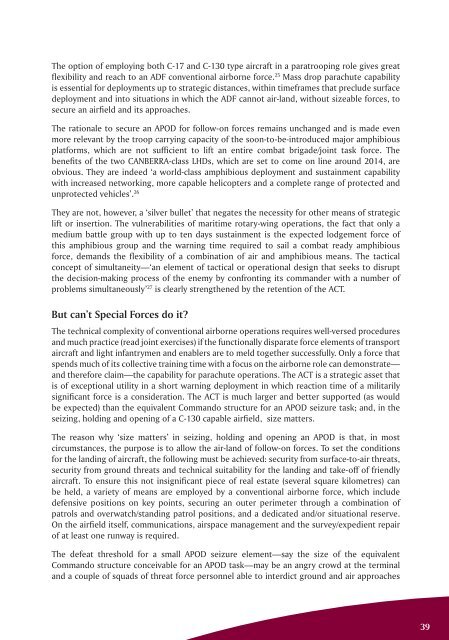ISSUE 183 : Nov/Dec - 2010 - Australian Defence Force Journal
ISSUE 183 : Nov/Dec - 2010 - Australian Defence Force Journal
ISSUE 183 : Nov/Dec - 2010 - Australian Defence Force Journal
Create successful ePaper yourself
Turn your PDF publications into a flip-book with our unique Google optimized e-Paper software.
The option of employing both C-17 and C-130 type aircraft in a paratrooping role gives greatflexibility and reach to an ADF conventional airborne force. 25 Mass drop parachute capabilityis essential for deployments up to strategic distances, within timeframes that preclude surfacedeployment and into situations in which the ADF cannot air-land, without sizeable forces, tosecure an airfield and its approaches.The rationale to secure an APOD for follow-on forces remains unchanged and is made evenmore relevant by the troop carrying capacity of the soon-to-be-introduced major amphibiousplatforms, which are not sufficient to lift an entire combat brigade/joint task force. Thebenefits of the two CANBERRA-class LHDs, which are set to come on line around 2014, areobvious. They are indeed ‘a world-class amphibious deployment and sustainment capabilitywith increased networking, more capable helicopters and a complete range of protected andunprotected vehicles’. 26They are not, however, a ‘silver bullet’ that negates the necessity for other means of strategiclift or insertion. The vulnerabilities of maritime rotary-wing operations, the fact that only amedium battle group with up to ten days sustainment is the expected lodgement force ofthis amphibious group and the warning time required to sail a combat ready amphibiousforce, demands the flexibility of a combination of air and amphibious means. The tacticalconcept of simultaneity—‘an element of tactical or operational design that seeks to disruptthe decision-making process of the enemy by confronting its commander with a number ofproblems simultaneously’ 27 is clearly strengthened by the retention of the ACT.But can’t Special <strong>Force</strong>s do it?The technical complexity of conventional airborne operations requires well-versed proceduresand much practice (read joint exercises) if the functionally disparate force elements of transportaircraft and light infantrymen and enablers are to meld together successfully. Only a force thatspends much of its collective training time with a focus on the airborne role can demonstrate—and therefore claim—the capability for parachute operations. The ACT is a strategic asset thatis of exceptional utility in a short warning deployment in which reaction time of a militarilysignificant force is a consideration. The ACT is much larger and better supported (as wouldbe expected) than the equivalent Commando structure for an APOD seizure task; and, in theseizing, holding and opening of a C-130 capable airfield, size matters.The reason why ‘size matters’ in seizing, holding and opening an APOD is that, in mostcircumstances, the purpose is to allow the air-land of follow-on forces. To set the conditionsfor the landing of aircraft, the following must be achieved: security from surface-to-air threats,security from ground threats and technical suitability for the landing and take-off of friendlyaircraft. To ensure this not insignificant piece of real estate (several square kilometres) canbe held, a variety of means are employed by a conventional airborne force, which includedefensive positions on key points, securing an outer perimeter through a combination ofpatrols and overwatch/standing patrol positions, and a dedicated and/or situational reserve.On the airfield itself, communications, airspace management and the survey/expedient repairof at least one runway is required.The defeat threshold for a small APOD seizure element—say the size of the equivalentCommando structure conceivable for an APOD task—may be an angry crowd at the terminaland a couple of squads of threat force personnel able to interdict ground and air approaches39
















